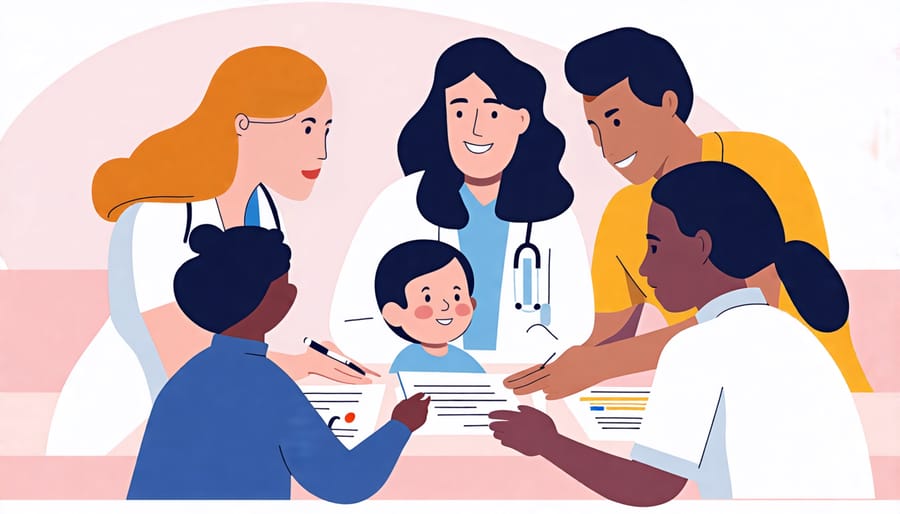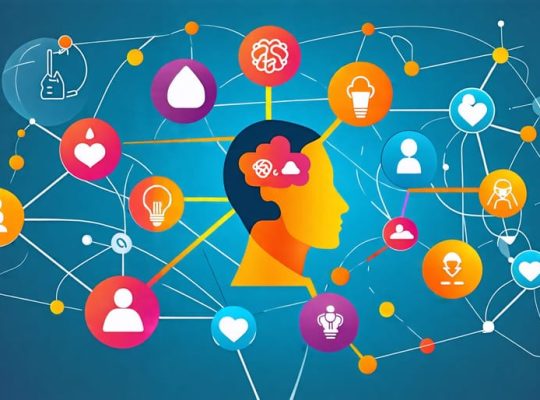Collaborative care models are revolutionizing children’s mental health by bringing together diverse teams of healthcare professionals to provide holistic, coordinated treatment. These innovative approaches break down silos between medical and behavioral health, enabling early identification of issues, seamless referrals, and integrated care plans tailored to each child’s unique needs. From school-based health centers staffed by therapists and pediatricians, to telepsychiatry consultations for primary care providers, collaborative models are expanding access to vital services. By wrapping support around the child and family, these exemplars of teamwork are transforming outcomes and bringing hope to countless young lives.

School-Based Mental Health Partnerships
Co-located mental health clinics
Co-located mental health clinics bring vital support directly to where children spend much of their time – in school. By integrating mental health professionals into the school setting, students can access counseling, therapy, and other services without the barriers of transportation or stigma. These clinics foster collaboration between educators and mental health providers, allowing for early identification of concerns and timely interventions. Therapists work closely with teachers to develop classroom strategies and accommodate students’ emotional needs. For parents, on-site clinics offer convenience and peace of mind, knowing their child can receive help readily. One mother shared, “Having a counselor at my daughter’s school has been a lifeline. She’s learning coping skills and gaining confidence.” Co-located clinics create a supportive environment that nurtures both academic and emotional growth, setting students up for long-term success. As one principal noted, “We’ve seen improvements in attendance, behavior, and overall well-being since partnering with mental health professionals on campus.”
Teacher consultation and training
Teacher consultation and training is a vital component of collaborative care models for children’s mental health. In this approach, mental health professionals work closely with educators to equip them with the knowledge and skills needed to support students’ emotional well-being. Through workshops, seminars, and one-on-one consultations, experts provide teachers with practical strategies for identifying and responding to mental health concerns in the classroom. This may include techniques for promoting positive behavior, fostering resilience, and creating a supportive learning environment. By empowering teachers to be proactive partners in mental health care, this model helps to bridge the gap between educational and clinical settings. It also ensures that students receive consistent, holistic support throughout their day. Ultimately, teacher consultation and training enables educators to play a crucial role in promoting mental health and catching potential issues early, leading to better outcomes for children and families.
Pediatric Primary Care Integration
Co-located mental health providers
The co-location of mental health providers, such as therapists and psychiatrists, within pediatric practices is a powerful collaborative care model. By working alongside pediatricians, these specialists can provide more timely and coordinated mental health care for children and adolescents. This integrated approach allows for early identification of mental health concerns, as providers can easily consult with each other and make referrals. Families also benefit from the convenience and familiarity of receiving care in their regular pediatric office. Co-located mental health providers can offer a range of services, including assessments, therapy, medication management, and care coordination. They work closely with pediatricians to develop comprehensive treatment plans that address both physical and mental health needs. This model breaks down barriers to accessing mental health care and promotes a holistic approach to child well-being. By bringing mental health expertise into the pediatric setting, co-location helps destigmatize seeking help and improves outcomes for children and families.

Collaborative care teams
In collaborative care teams, pediatricians work closely with care managers and mental health specialists to provide comprehensive, coordinated care for children’s physical and mental well-being. Care managers, often nurses or social workers, serve as a vital link between the pediatrician, mental health specialist, and the child’s family. They help assess the child’s needs, develop personalized care plans, and ensure smooth communication among all team members.
Mental health specialists, such as child psychologists or psychiatrists, offer expert guidance on diagnosing and treating mental health conditions. They collaborate with pediatricians to develop evidence-based treatment plans tailored to each child’s unique needs. This integrated approach ensures that children receive the right care at the right time, with their physical and mental health needs addressed holistically.
By fostering open communication and shared decision-making, collaborative care teams create a supportive environment where families feel heard, understood, and empowered to actively participate in their child’s care journey.
Wraparound Services
Wraparound services provide a comprehensive, family-centered approach to supporting high-risk youth with complex needs. These programs bring together a team of professionals from various systems, such as mental health, education, child welfare, and juvenile justice, to coordinate care and address the unique challenges faced by each child and their family.
At the heart of wraparound services is the belief that the best outcomes are achieved when the entire family is engaged and supported. Care coordinators work closely with families to identify strengths, needs, and goals, and to develop individualized plans that leverage community resources and natural supports.
One key aspect of wraparound services is the emphasis on collaboration and communication among all team members. Regular meetings bring together the family, care coordinator, therapists, teachers, social workers, and other relevant professionals to share information, monitor progress, and adjust plans as needed. This integrated approach ensures that everyone is working together towards common goals.
Wraparound services also prioritize cultural competence and family voice and choice. Care plans are tailored to the unique values, beliefs, and preferences of each family, and youth and caregivers are actively involved in decision-making throughout the process.
Research has shown that wraparound services can lead to improved mental health outcomes, reduced out-of-home placements, increased school attendance and performance, and strengthened family functioning. By providing a safety net of support that spans multiple systems, these programs help high-risk youth and their families build resilience, overcome challenges, and thrive.

Telehealth Collaborations
Telehealth collaborations are revolutionizing access to mental health care for children, especially in underserved communities. By leveraging secure video conferencing platforms, these innovative partnerships connect families with remote specialists for comprehensive evaluations, play therapy, counseling sessions, and medication management.
One inspiring example is the collaboration between rural school districts and university-based mental health clinics. Through this partnership, students can receive expert care right from their school counselor’s office, eliminating transportation barriers and reducing missed class time. The remote specialists work closely with on-site staff to develop personalized treatment plans and monitor progress.
Another impactful telehealth model involves partnerships between pediatric practices and mental health providers. By integrating behavioral health consultations into routine check-ups via telehealth, primary care physicians can more easily identify concerns and connect families with the appropriate resources. This proactive approach helps catch issues early and prevents them from escalating.
Mobile health clinics equipped with telehealth capabilities are also bringing care directly to underserved neighborhoods. These programs often collaborate with local nonprofits to build trust and provide culturally sensitive support. Children can receive virtual assessments, therapy, and medication management from the comfort of the mobile clinic, with in-person staff available to assist and advocate for their needs.
As telehealth continues to evolve, these collaborations are breaking down barriers and ensuring that every child, regardless of location or background, has access to the mental health support they need to thrive. By combining technology with human connection and expertise, we’re creating a brighter, more equitable future for children’s well-being.
Family Peer Support Programs
Family peer support programs are a unique and valuable component of collaborative care models for child mental health. These initiatives train family members who have firsthand experience navigating the challenges of caring for a child with mental health needs to provide support, advocacy, and guidance to other families facing similar situations. By harnessing the power of shared experience and empathy, family peer support programs offer a level of understanding and connection that traditional clinical services may not always provide.
Peer support specialists can help families feel less alone, validate their experiences, and provide practical advice on managing day-to-day challenges. They can also assist in navigating complex healthcare systems, connecting families with appropriate resources, and advocating for their needs. This unique blend of emotional support and service navigation can be incredibly empowering for families who may feel overwhelmed or lost in the face of their child’s mental health struggles.
Research has shown that peer-delivered services can lead to improved engagement in treatment, better coping skills for families, and reduced feelings of stigma and isolation. By integrating family peer support programs into collaborative care models, healthcare providers can offer a more comprehensive and family-centered approach to child mental health care that recognizes the crucial role of family support and lived experience in the recovery process.
Conclusion
The collaborative care model has the power to transform children’s mental health outcomes by fostering teamwork, communication, and holistic support. By bringing together medical providers, mental health specialists, educators, and families, this approach ensures that children receive comprehensive, coordinated care that addresses their unique needs. The examples showcased in this article demonstrate the effectiveness and adaptability of collaborative care across various settings, from schools to healthcare clinics.
Increased adoption and investment in collaborative care models can make a significant difference in the lives of countless children and families. By prioritizing mental health as an integral part of overall well-being and providing the necessary resources and support, we can create a brighter future for the next generation. It is crucial that policymakers, healthcare organizations, schools, and communities work together to implement and expand these innovative approaches.
For readers interested in learning more or getting involved, there are numerous resources available. Organizations such as the National Alliance on Mental Illness (NAMI) and the American Academy of Pediatrics offer valuable information and support for families and professionals. By educating ourselves, advocating for change, and working collaboratively, we can ensure that every child has access to the mental health care they need to thrive. Together, we can build a stronger, more compassionate society that prioritizes the well-being of our children.







